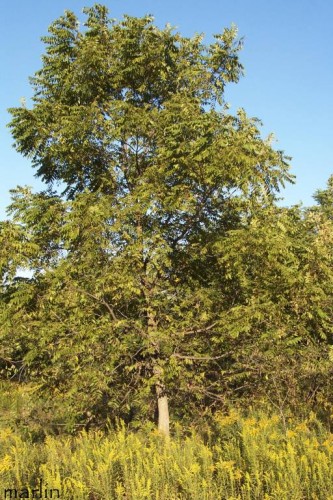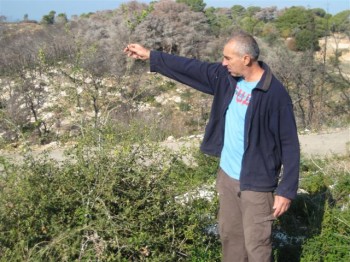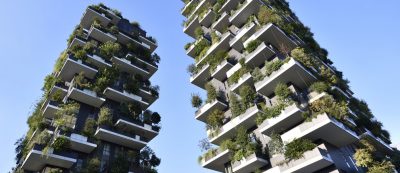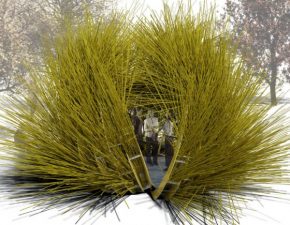 Walnut floors and bookshelves gives “warmth”, but at a cost of live trees that take 50 years to grow
Walnut floors and bookshelves gives “warmth”, but at a cost of live trees that take 50 years to grow
The use of ornate wood products in building homes, furniture and ships has been part of humanity since time began. Even the Bible gives note to using wood for ornate construction projects with such examples as King David living in “a palace made of cedar”, and of King Hiram of Tyre sending his best wood craftsmen and “trunks of cedar” to King Solomon in Jerusalem for use in building the First Temple for the Jewish people. With world forests being depleted at a very rapid rate, continued use of wood in architectural projects as well as for furniture has often been put into question as whether this practice is sustainable in today’s climate changing world. Wood can be used as a carbon sink, but what if it’s being shipped around the world?
 American black walnut tree in its prime
American black walnut tree in its prime
Wood flooring and even parquet flooring, often makes use of recycled wood products as is planned for a new green eco tower in Tel Aviv Israel. A project in which American walnut hardwood was used in architecture could be an issue in the recently awarded construction of a library at Zayed University in Abu Dhabi. This project, which cost $4 million USD and entailed the use of American walnut hardwood for building the library bookshelves and flooring was selected due to the walnut wood’s beauty and durability. T
he resulting project enabled it to win an award from the American Hardwood Export Council (AHEC) which is a leading international trade association for the American hardwood industry.
Just positive PR for itself?
The choice of American walnut for use in the library was explained by Carrie Das, design manager with AHK International: “We had chosen to use American walnut across the whole library because of its … straight grained appearance and its durability, being highly resistant to heartwood decay. It was also able to warm the environment and simultaneously provides a modern, classic and comfortable feeling.”
While this beautiful wood certainly does create a feeling of warmth, it undoubtedly did so at the expense of a great number of walnut trees that take much longer to grow to maturity than other types of wood such as pine and fir.
The length of time for re- growth of hardwood trees, including those like oak was recently pointed out following the disastrous Carmel Forest fire in Israel in which more than 30 thousand Dunam (3,000 hectare) for pine and hardwood forest were destroyed in early December 2010. This included a significant portion of forestland and residences at nearby Kibbutz Beit Oren.
 “It takes 50 years or longer for hardwood trees to be fully grown” says Sela Rotenberg
“It takes 50 years or longer for hardwood trees to be fully grown” says Sela Rotenberg
Beit Oren’s resident ecologist, Sela Rotenberg explained to Green Prophet that it takes only 15 to 20 years for pine trees to reach maturity; but that hardwood trees like oak take 50 years or longer. This also holds true for replacing the American hardwood trees that were harvested for their wood to construct the Abu Dhabi library.
A more feasible idea, from an ecological standpoint, could involve the use of recycled wood products from doors and other wood products for making parquet flooring and in constructing tables and bookshelves.
It’s not that we are advocating the non-use of wood in designing such projects as the library, but simply to incorporate a more sustainable use of wood by recycling wood already used in other products; thereby saving some live trees. A trend in North America is to re-use old wood. Or to purchase trees grown sustainably and sustainably harvested.
::Hardwood Floors Manufacturing
More about wood use issues in building and design:
13 Principals of Sustainable Architecture from Nadir Khalili Student
Recycled Furniture From Middle East Rugs and Doors
Studio Ubico’s Furniture Collection Reincarnates Wood into Trees
Tel Aviv’s $60 Million Sustainable Office Tower A Go




Very interesting post, Maurice! I think in the future wood material will be used less because of the new high-end technologies such as 3D printers. They’ve started to use them for printing entire houses… I guess wood material won’t be necessary because in 20 years they wood probably print “fake” hardwood floors for instance that will be just the same as real wood floors.
I have to agree with the post by Rupert Oliver, short growth rotations do not make for a greener product. In fact, short rotation monoculture “crops” often require more intensive site preparation, planting, pesticides, fertilizer, thinning, and harvesting. All of these processes increase soil erosion and embodied energy and decrease water quality and biodiversity. These intensive site and harvest impacts are not a part of a natural sustainably managed hardwood forest. Periodic selective harvesting of Walnut, for example, in combination with natural regeneration leaves the forest intact preserving soil, water quality, and biodiversity. We spend hours in the classroom and in the field demonstrating these concepts to our students studying for a degree in forest management.
We also need to consider the diameter of the log harvested. The recovery from a 24 inch walnut log as a percentage of useable wood (useable wood vs. sawdust, slab, etc.) is much higher than for a smaller diameter pine log half its size. For example, it would take five 12 inch pine logs (8 feet long) to equal the lumber volume sawn from one 24 inch walnut log (8 feet long). This translates into more energy in harvesting and processing to get the same lumber volume.
I do not mean to disparage pine management and use in any way. Wood in general (both hardwood and softwoods) have smaller environmental impacts than non-wood substitutes. The same cannot be said for a non-wood substitute such as steel or a short rotation non-wood substitute such as bamboo. We must look at the larger picture of natural resource management and the individual product life cycle to bring science to “green products.”
Interesting comment mainly because it reveals the level of misunderstanding – even amongst those claiming to be “green prophets” – of the impact of different forestry operations on the environment, and also the perils of basing green comparisons on single issues rather than a full scientific life cycle assessment (LCA).
The case in favour in pine and fir at the expense of walnut is built entirely on the relative length of forest rotations (time between harvests), drawing on the mistaken assumption that shorter rotations are necessarily more environmentally benign. There is no relationship whatsoever between rate of tree growth and the sustainability of harvested wood. You’ve also got to take account of the size of the forest resource – which in the case of walnut is vast. Even the slowest growing hardwoods can be managed sustainably if the area of forest is large enough and the length of time between harvests long enough.
Analysis of U.S. government forest inventory data gathered at regular intervals over the last 60 years shows that the U.S. walnut harvest averages around 1 million m3 each year, well below the annual growth rate of 3.6 million m3. Even after harvesting, an additional 2.6 million m3 of walnut accumulates in U.S. forests every year. Even assuming that only 10% of this production is of quality suitable for a high-profile project like that in Abu Dhabi, it would take only around 90 seconds for new growth in the U.S hardwood forest to replace each cubic meter of walnut used!
Also noteworthy that nowadays many forest scientists argue that rotations in certain forests types should be lengthened so that forests provide greater biodiversity benefits and have longer to accumulate carbon before harvesting.
While there is no doubt that pine would, like Walnut, have many environmental advantages compared to alternative non-wood materials, it’s much more questionable that it would offer a better environmental option than walnut. Pine often derive from fast growing plantations, whereas walnut more often comes from managed natural forests. The latter tend to provide greater biodiversity benefits and to produce more durable wood products that need to be replaced less often.
Of course these are all complex issues – so the “green prophet” may be forgiven for failing to take them all into account. Best to rely on full blown peer-reviewed life cycle assessment – something that the US hardwood industry is also taking a lead on.